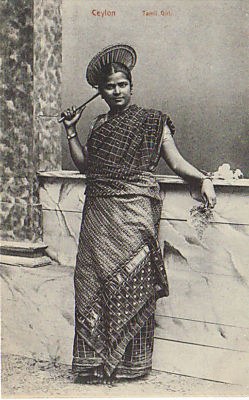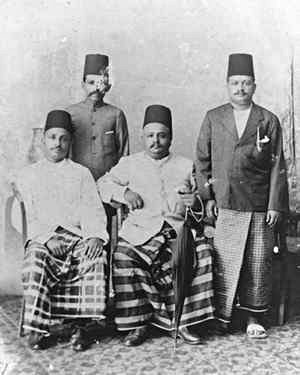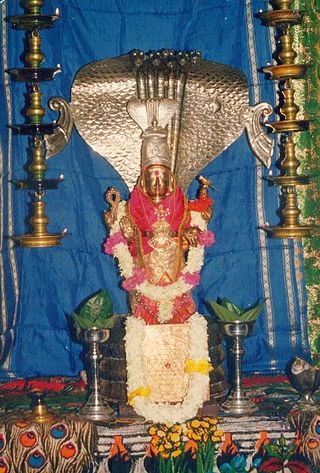Related Research Articles

Tamil is a Dravidian language natively spoken by the Tamil people of South Asia. Tamil is an official language of the Indian state of Tamil Nadu and union territory of Puducherry, and the sovereign nations of Sri Lanka and Singapore. Tamil is also spoken by significant minorities in the four other South Indian states of Kerala, Karnataka, Andhra Pradesh and Telangana, and the Union Territory of the Andaman and Nicobar Islands. It is also spoken by the Tamil diaspora found in many countries, including Malaysia, Myanmar, South Africa, United Kingdom, United States, Canada, Australia, New Zealand, United Arab Emirates, Saudi Arabia, France, Germany, Italy, Indonesia, and Mauritius. Tamil is also natively spoken by the Sri Lankan Moors. One of 22 scheduled languages in the Constitution of India, Tamil was the first to be classified as a classical language of India.

The Tamils, also known as the Tamilar, are a Dravidian ethnolinguistic group who natively speak the Tamil language and trace their ancestry mainly to India's southern state of Tamil Nadu, to the union territory of Puducherry, and to Sri Lanka. The Tamil language is one of the world's longest-surviving classical languages, with over 2000 years of Tamil literature, including the Sangam poems, which were composed between 300 BCE and 300 CE.

Sri Lankan Tamils, also known as Ceylon Tamils or Eelam Tamils, are Tamils native to the South Asian island state of Sri Lanka. Today, they constitute a majority in the Northern Province, form the plurality in the Eastern Province and are in the minority throughout the rest of the country. 70% of Sri Lankan Tamils in Sri Lanka live in the Northern and Eastern provinces.

Tamilakam was the geographical region inhabited by the ancient Tamil people, covering the southernmost region of the Indian subcontinent. Tamilakam covered today's Tamil Nadu, Kerala, Puducherry, Lakshadweep and southern parts of Andhra Pradesh and Karnataka. Traditional accounts and the Tolkāppiyam referred to these territories as a single cultural area, where Tamil was the natural language and permeated the culture of all its inhabitants. The ancient Tamil country was divided into kingdoms. The best known among them were the Cheras, Cholas, Pandyans and Pallavas. During the Sangam period, Tamil culture began to spread outside Tamilakam. Ancient Tamil settlements were also established in Sri Lanka and the Maldives (Giravarus), prior to the migration of Prakrit speakers.
Bharatha People also known as Bharatakula and Paravar, is an ethnicity in the island of Sri Lanka. Earlier considered a caste of the Sri Lankan Tamils, they were classified as separate ethnic group in the 2001 census. They are descendant of Tamil speaking Paravar of Southern India who migrated to Sri Lanka under Portuguese rule. They live mainly on the western coast of Sri Lanka and mainly found in the cities of Mannar, Negombo and Colombo.
Karaiyar is a Sri Lankan Tamil caste found mainly on the northern and eastern coastal areas of Sri Lanka, and globally among the Tamil diaspora.

The Sri Lankan Tamil dialects or Ceylon Tamil or commonly in Tamil language Eelam Tamil are a group of Tamil dialects used in Sri Lanka by its native Tamil speakers that is distinct from the dialects of Tamil spoken in Tamil Nadu. It is broadly categorized into three sub groups: Jaffna Tamil, Batticaloa Tamil, and Negombo Tamil dialects. But there are a number of sub dialects within these broad regional dialects as well. These dialects are also used by ethnic groups other than Tamils and Muslims such as Sinhalese people, Portuguese Burghers and the indigenous Coastal Vedda people.
Loan words in Sri Lankan Tamil came about mostly due contact between colonial powers and the native population. Linguists study a language's lexicon for a number of reasons. Languages such as Tamil with centuries of literature and multi-cultural contact offer the chance to compare the various processes of lexical change. The words of foreign origin or loanwords illustrate those processes: calques, loanwords, the distinction between function words and content words.

Sri Lankan Moors are an ethnic minority group in Sri Lanka, comprising 9.3% of the country's total population. Most of them are native speakers of the Tamil language. The majority of Moors who are not native to the North and East also speak Sinhalese as a second language. They are predominantly followers of Islam. The Sri Lankan Muslim community is mostly divided between Sri Lankan Moors, Indian Moors, Sri Lankan Malays and Sri Lankan Bohras. These groups are differentiated by lineage, language, history, culture and traditions.
Negombo Tamil dialect or Negombo Fishermen's Tamil is a Sri Lankan Tamil language dialect used by the fishers of Negombo, Sri Lanka. This is just one of the many dialects used by the remnant population of formerly Tamil speaking people of the western Puttalam District and Gampaha District of Sri Lanka. Those who still identify them as ethnic Tamils are known as Negombo Tamils or as Puttalam Tamils. Although most residents of these districts identify them as ethnic Sinhalese some are bilingual in both the languages.
Thanjavur Marathi, also spelled as Tanjore Marathi, is a dialect of Marathi spoken by Thanjavur Maharashtrians who migrated south, along with Shivaji's half brother Venkoji, to the areas surrounding the city of Thanjavur in Tamil Nadu, India back in the 17th century.
Sri Lankan Tamil literature or Ceylon Tamil literature refers to Tamil literature produced in the current day country of Sri Lanka by various Tamil speaking communities such as the Sri Lankan Tamils, Indian Tamils of Sri Lanka and Sri Lankan Muslims. The earliest extant records survived from the Sangam age academies and continued in the medieval era in the courts of the Jaffna kingdom until modern times. The destruction of the Saraswathy Mahal library of Nallur and the burning of Jaffna library led to the loss of a large tract of Sri Lankan Tamil literature, although much survives through oral traditions and the unearthing and preservation of palm-leaf manuscripts, copper plate inscriptions & stone inscriptions.
Sri Lankan Vellalar is a caste in Sri Lanka, predominantly found in the Jaffna peninsula and adjacent Vanni region, who comprise about half of the Sri Lankan Tamil population. They were traditionally involved in agriculture, but also included merchants, landowners and temple patrons. They also form part of the Sri Lankan Tamil diaspora.
Tamil phonology is characterised by the presence of "true-subapical" retroflex consonants and multiple rhotic consonants. Its script does not distinguish between voiced and unvoiced consonants; phonetically, voice is assigned depending on a consonant's position in a word, voiced intervocalically and after nasals except when geminated. Tamil phonology permits few consonant clusters, which can never be word initial.

Nainativu, is a small but notable island off the coast of Jaffna Peninsula in the Northern Province, Sri Lanka. The name of the island alludes to the folklore inhabitants, the Naga people. It is home to the Hindu shrine of Nagapooshani Amman Temple; one of the prominent 64 Shakti Peethas, and the Buddhist shrine Nagadeepa Purana Viharaya.

The Naga people are believed by some to be an ancient tribe who once inhabited Sri Lanka and various parts of Southern India. There are references to Nagas in several ancient texts such as Mahavamsa, Manimekalai, Mahabharata and also in other Sanskrit and Pali literature. They were generally represented as a class of super-humans taking the form of serpents who inhabit a subterranean world.
Kudiramalai is a cape and ancient port town on the west coast of Sri Lanka.
Batticaloa Tamil dialect is shared between Tamils, Moors, Veddhas and Portuguese Burghers in the Batticaloa-Amparai region of the Eastern Province, Sri Lanka. The Tamil dialect used by residents of the Trincomalee District has many similarities with the Jaffna Tamil dialect. According to Kamil Zvelebil a linguist, the Batticaloa Tamil dialect is the most literary like of all spoken dialects of Tamil, and it has preserved several antique features, and has remained more true to the literary norm than any other form of Tamil while developing a few striking innovations. Although Batticaloa Tamil has some very specific features of vocabulary, it is classified with other Sri Lankan Tamil dialects as it is related to them by characteristic traits of its phonology. It also maintains some words that are unique to present day. Also, the dialect has less influence of Sanskrit.
Sri Lankan Paraiyar is a Tamil caste found in northern and eastern Sri Lanka. They are traditional parai-drummers who were also involved in weaving and scavenging.
Sri Lankan Pallar is a Tamil caste found in northern and eastern Sri Lanka. They are traditionally involved in agriculture and were also involved in toddy tapping and artisanal fishing.
References
- ↑ Denham, E. B. (1912). Ceylon at the Census of 1911. (n.p.): H. C. Cottle, government printer, Ceylon.
- ↑ www.viruba.com http://www.viruba.com/Nigandu/WebForm3.aspx?aspxerrorpath=/tamilwritings/00010.aspx . Retrieved 2023-02-09.
{{cite web}}: Missing or empty|title=(help) - ↑ Ragupathy, Tamil Social Formation in Sri Lanka: A Historical Outline, p.1
- ↑ Current trends in linguistics: Linguistics in South Asia. Volume 5. (1969). Germany: Mouton.
- ↑ THE PHONOLOGY OF NOMINAL FORMS IN JAFFNA TAMIL by Sabaratnasinghe Thananjayaraoasingham
- ↑ Kuiper, F. B. J. (1997). Selected Writings on Indian Linguistics and Philology. Netherlands: Rodopi.